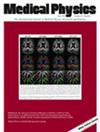Feasibility of volumetric-modulated arc therapy gating for cardiac radioablation using real-time ECG signal acquisition and a dynamic phantom
Abstract
Background
Stereotactic arrythmia radioablation (STAR) is a noninvasive technique to treat ventricular tachycardia (VT). Management of cardiorespiratory motion plays an essential role in VT-STAR treatments to improve treatment outcomes by reducing positional uncertainties and increasing dose conformality. Use of an electrocardiogram (ECG) signal, acquired in real-time, as a surrogate to gate the beam has the potential to fulfil that intent.
Purpose
To investigate the gated delivery of volumetric-modulated arc therapy (VMAT) for STAR on a TrueBeam linear accelerator (linac) using a real-time acquired ECG signal and a dynamic cardiac phantom.
Methods and materials
Dosimetric characteristics of a 6 MV flattening filter free (FFF) beam from a Varian TrueBeam linac were initially evaluated under high-frequency gating scenarios relevant to cardiac rhythms with respect to dose linearity, beam output, and energy quality. A microcontroller board was used to interface and gate the linac, sending a beam on/off signal. For real-time cardiac gated measurements, an AD8232 Heart Monitor board was used to acquire the ECG signal and synchronize the VMAT delivery to an ArcCHECK detector to a specific phase of the cardiac cycle. Gated dose distributions were compared against those acquired for a non-gated delivery mode. An in-house dynamic cardiac phantom was developed to simulate cardiorespiratory motion that correlates target position with the signal to gate the beam. Measured dose distributions using gafchromic film were also compared against the static (reference) mode in different scenarios with and without gating.
Results
Maximum difference in dose per monitor unit (MU) was found to be no greater than 1% as compared to static mode with variation in the chamber response within 0.2% in the range of 50 MUs to 200 MUs. Maximum percentage differences for the beam output and beam qualiy index (TPR20,10) between gated and non-gated modes were 0.91% and -0.44%, respectively. Comparison of delivered dose distributions for the VMAT plan without gating versus ECG synchronized gating modes provided a passing rate 98% for the gamma analysis with 1% relative dose difference, 1 mm distance-to-agreement criteria. For the synchronization of dose delivery with target position, passing rates were 98%, 97%, and 99% for the axial, coronal, and sagittal planes, respectively, when gating the beam based on target position for cardiac motion only, for 3%, 3 mm tolerance as compared to static mode. Without gating the beam, passing rates of the respective plans are 97%, 94%, and 99% for the cardiac motion only, and 67%, 57%, and 55% when including respiratory component of motion.
Conclusion
A 6 MV-FFF TrueBeam is stable for performing gating in STAR under high-frequency gate windows within typical cardiac cycles. Agreement between measured dose distributions for a VMAT plan in static and ECG-synchronized deliveries and between static and target-position gated modes shows that the proposed methodology is feasible and can be implemented on a TrueBeam platform.


 求助内容:
求助内容: 应助结果提醒方式:
应助结果提醒方式:


